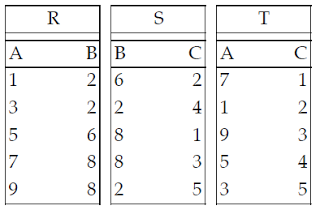Welcome to the DBMS MCQs Page
Dive deep into the fascinating world of DBMS with our comprehensive set of Multiple-Choice Questions (MCQs). This page is dedicated to exploring the fundamental concepts and intricacies of DBMS, a crucial aspect of UGC CBSE NET Exam. In this section, you will encounter a diverse range of MCQs that cover various aspects of DBMS, from the basic principles to advanced topics. Each question is thoughtfully crafted to challenge your knowledge and deepen your understanding of this critical subcategory within UGC CBSE NET Exam.
Check out the MCQs below to embark on an enriching journey through DBMS. Test your knowledge, expand your horizons, and solidify your grasp on this vital area of UGC CBSE NET Exam.
Note: Each MCQ comes with multiple answer choices. Select the most appropriate option and test your understanding of DBMS. You can click on an option to test your knowledge before viewing the solution for a MCQ. Happy learning!
DBMS MCQs | Page 9 of 23
Explore more Topics under UGC CBSE NET Exam
List-I List-II
(a) Normalization (i) Enforces match of primary key to foreign key
(b) Data Dictionary (ii) Reduces data redundancy in a database
(c) Referential Integrity (iii) Define view(s) of the database for particular user(s).
(d) External Schema (iv) Contains metadata describing database structure.
Codes:
(a) (b) (c) (d)
F={AD→E, BE→F, B→C, AF→G}
Which of the following is a candidate key?
(a) The ability to develop more realistic models of the real world.
(b) The ability to represent the world in a non-geometric way.
(c) The ability to develop databases using natural language approaches.
(d) The need to split objects into their component parts.
(e) The ability to develop database models based on location rather than state and behaviour.
Create table test(
one integer,
two integer,
primary key(one),
unique(two),
check(one≥1 and ≤10),
check(two≥1 and ≤5) );
How many data records/tuples atmost can this table contain ?
SQ1 : Select *
From R Full Join S
On R.B=S.B;
SQ2 : Select *
From R Inner Join S
On R.B=S.B;
The numbers of tuples in the result of the SQL query SQ1 and the SQL query SQ2 are given by :
(a) Select Name from people where Age>21;
(b) Select Name from people where Height>180;
(c) Select Name from people where (Age>21) or (Height>180);
If the SQL queries (a) and (b) above, return 10 rows and 7 rows in the result set respectively, then what is one possible number of rows returned by the SQL query (c) ?
What is the resulting table of πA,B(R⨝T) ⨝ πB,C(S⨝T) ?


Suggested Topics
Are you eager to expand your knowledge beyond DBMS? We've curated a selection of related categories that you might find intriguing.
Click on the categories below to discover a wealth of MCQs and enrich your understanding of Computer Science. Happy exploring!








